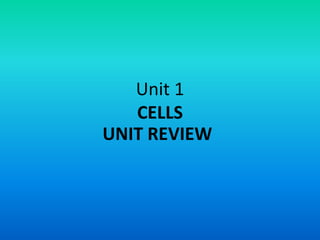
Unit 1 review
- 1. Unit 1 CELLS UNIT REVIEW
- 2. What have you learned?
- 3. What type of cells are these?
- 4. WHERE are blood cells made? *Bone marrow/connective tissue/skeletal system
- 5. In which organ system can you find these cells? *Bone – Skeletal System
- 6. Which of the following is not an example of connective tissue?
- 7. Where did these cells come from? *Cheek – Epithelial tissue
- 8. WHERE could you find these cells? *Brain What type of tissue is made up of these cells? *Nervous
- 9. Which statement IS part of the cell theory? a. All cells contain a cell membrane AND cell wall. b. All cells contain a nucleus. c. Cells come from pre-existing cells. d. Microscopes are needed to see cells.
- 10. What is the function of the cell membrane? To control what comes in and out of the cell.
- 11. Passive transport does NOT require energy. Which of the following is a form of passive transport? a. Osmosis b. Diffusion c. Neither d. Both a and b
- 12. What is a characteristic of a living thing? a. Reproduction b. Made up of cells c. Pass down traits to offspring d. All of the above *Also…metabolism & homeostasis
- 13. Which of the following organelles can be found in BOTH animal and plant cells? a. Cell membrane b. Cell wall c. Chloroplasts d. Lysosomes
- 14. In a city, which of the following would NOT make a good analogy for the nucleus of the cell? a. Mayor’s office b. Town Hall c. Police station
- 15. Which of the following terms would best complete the statement below? produces uses stores eliminates The mitochondria _____________ energy for the cell.
- 16. Place the following in order in terms of LEAST complex to MOST Complex. Tissue Organism Organ Organ system Cell
- 18. Passive Transport in Red Blood Cells 600 *Greatest rate Number of Wa ter Molecule s Diffusing (second) Beak er B Very 500 of diffusion salty 400 Beak er A A lil’ 300 salt 200 Plasma Beak er C 100 0 20 40 60 Temp erature °C
- 19. What would be a good problem statement for the experiment for which the data was shown on the previous graph? Does temperature affect osmosis in blood cells?
- 20. Match the organelles to the structure description provided Nucleus Jelly-like substance that contains organelles Cytoplasm Bilayered membrane with pores Cell membrane Contains genetic material
- 21. Organization of Body 21